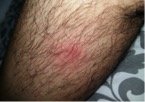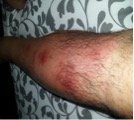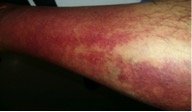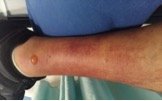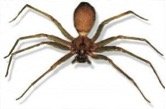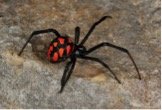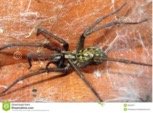- Fabrizia Navone
- Review
Poisonous spider bites
- 1/2019-Febbraio
- ISSN 2532-1285
- https://doi.org/10.23832/ITJEM.2019.011
Fabrizia Navone , Paolo Balzaretti, Domenico Vallino
Emergency Department Mauriziano Hospital, Turin, Italy
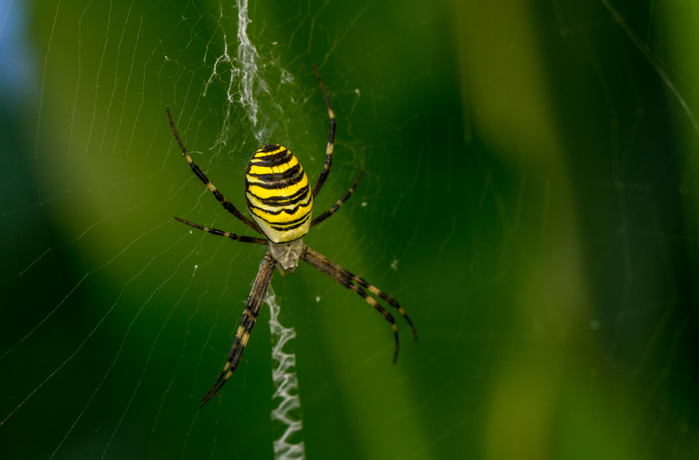
Abstract
It also describes the various species of poisonous spiders present in Italy and in most of Europe, their behavior and the potential effects of their poison injected after biting.
Case Report
Mr. CM, 44 years old, came in the ED of the Mauriziano Hospital one Monday late afternoon for a spider bite. At medical interview the patient reported that the previous Saturday afternoon, while he was in the countryside near Latina, he felt a painful tingling in the lower left limb and noticed the presence of a small spider, that he crushed. Subsequently, on the suspected points of bites, appeared a reddened lesion on the leg that have spread to the entire limb associated with swelling and pain.
At medical examination the patient was febrile (TC 38 ° C), the left lower limb appeared edematous and it was painful to the touch, with widespread erythema and subcutaneous purpura up to the knee. Some livid stains appeared in the points identified as biting sites and there was a large medial malleolar blister.
Figure 1. Day 1 after bites
Figure 2. Day 2 after bites
Figure 3. Day 3 – At the visit in ED
The rest of the clinical objectivity was silent but the clinical appearance of the lower left limb appeared to be worrisome. A CUS had excluded the presence of TVP. The blood tests were normal unless for an increase in CRP (49.1 mg / dl, n.v. <5.0) and neutrophilic leukocytosis (WBC 14.700). So we made a decision to hold the patient in ED. During the hospitalization it was administered paracetamol as needed, steroid therapy, subcutaneous heparin and antibiotic therapy with doxycycline. No tetanic antitoxin was administered because the patient was immunized. The days after we noted a progressive improvement of the clinical status. Two days later the leg appeared less edematous, the skin spots were in defervescence; the malleolar blister remained; the patient was no longer febrile. The control of the blood tests showed CRP with stable values (50.1 mg / dl n.v.<5.0) and a reduction of the neutrophilic leukocytosis (WBC 12.170).
Figure 4. Day 5 after bites
Therefore we decided for the discharge and a re-evaluation in ED 3 days after. We also had given a recommendation to continue the therapy with steroids, doxycycline and subcutaneous heparin. At the re-evaluation visit the patient appeared in good clinical conditions, the lower left limb was further improved with the reduction of the edema and the cutaneous purpura; the malleolar blister was still present but reduced. Therefore, it was not considered necessary to make new blood tests and the patient was discharged with the recommendation to continue the antibiotic therapy for 6 more days, to halve the dosage of the steroid and to continue it for 6 more days, instead subcutaneous heparin therapy was interrupted; we also recommended to cover the blister until the complete resorption.
Figure 5. Day 8 after bites
Discussion
Violin spider (Loxosceles Rufescens)
It is a very poisonous arachnoid, the name of the belonging family derives from the Latin sicarium which means “killer”. The violin spider lives in the tunnels, in the cracks of the trees and under the rocks. It loves the mild climate, for this reason it is often found in homes where it is a serious danger for those who live there. Cellars, attics, garages, closets, furniture, dark places and little frequented in general. When it settles in homes it can take refuge inside shoes, clothes, sheets, furniture. It is not an aggressive spider, when possible it always tries to escape, but if you accidentally step on it, it defends itself by biting. It is a nocturnal animal. It does not use the cobweb to capture prey, but moves away from it to look elsewhere for food (various insects). Once detected the prey injects the poison that immobilizes it and starts the digestion of the internal organs.
The violin spider has a necrotizing poison which therefore does not act on the nervous system but has a degenerative effect on the tissues adjacent to the area where the bite occurred. It is composed of a mixture of enzymes, proteins and non-enzymatic polypeptide. Phospholipases D are identified as deleterious components of venom involved in noxious activities. Phospholipases D interact with cell membranes and other elements in tissue triggering alterations which involve the complement system and activation of neutrophils. More important is the response of host cells to the presence of a complement mediating foreing substance. (5-6)
The Phospholipase D family is the cause for dermonectotic skin lesions in humans bitten from Violin Spider and it is the main component of the venom responsible for the local and systemic effects observed in loxoscelitism. The loxosceles venom is a potent inducer of multiple inflammatory mediating chemokines such as IL-8 and chemokine growth-regulated protein alpha or chemokines including monocyte chemotrattactant protein-1 (7)
The bite of the violin spider is not painful so usually it is not noticed immediately. In the case of a bite with venom the symptoms occur within 30/60 minutes. In the part affected by the bite an irregular red zone forms with some bubbles that at the same time becomes itchy. Over time, the situation worsens and more or less severe ulcers can form. In most cases healing occurs spontaneously and very slowly, the scar remains. Sometime can be concomitant severe systemic effects include fever, chills myalgia arthralgia and generalized rash, hemolysis, jaundice, rhabdomyolysis, renal failure, disseminated intravascular coagulation, coma and shock. (8)
The treatment of the violin spider bites is still unsatisfactory. Treatments suggested, as for most spider bites, include analgesic, antibiotics, tetanus toxoid and bite site cleaning. Although no specific therapy exist, it has been suggested dapsone, heparin, steroids, hyperbaric oxygen treatments and /or surgical excision may be beneficial (9).
As a result necrosis may take many weeks or months to heal. It can be supposed a toxic effect of spider venom is about 5 weeks: consequently early excision is unnecessary, wait and see approach is the best treatment.(10-11-12)
Malmignatta (Latrodectus tredecimguttatus)
Malmignatta is known as a black Mediterranean Widow and a black European Widow, all potentially poisonous. Loves dry and stony places. It is easy to meet in the low Mediterranean scrub, in the prairies, in the steppes, among the stones or hidden in the dry stone walls. It can be a problem in places where wheat is still harvested by hand. During mating, the female sometimes devours the male, so they are called black widows. The black widow feeds on substances in liquid form: it injects the gastric juices into the victims to liquefy the inside, once they have done this they suck.
For humans it is only the bite of females to be dangerous. The venom is neurotoxic, acting on the nervous system. Fortunately it usually injects a small amount that cannot kill man. The bite is painful but rarely fatal. The bite of this spider immediately creates a slight reddening of the skin and swelling; within 24 hours numerous symptoms can be manifested: muscle pains in the bite area, cramps in the abdomen, headache, dizziness, nausea and vomiting, tremors, hyperventilation, anxiety and insomnia, excessive sweating and / or salivation, hypertension Usually the symptoms after a couple of days tend to diminish until they disappear completely even without medical treatment. Throughout the months following the bite it is possible to feel tingling in the area of the bite, muscle spasms, nervousness and weakness. Only in very rare cases may be more severe symptoms related to the bite: priapism, myocarditis, paralysis, kidney failure, miscarriage, anaphylactic shock, coma.
Although there is the possibility of contracting a shock that leads to death, the mortality rate due to the bite is close to zero. The age group most at risk are children because of lower body mass. (13)
Conclusions
In light of the clinical framework and the evolution , after having been documented, we thought that the yellow-sac spider could be responsible for the infection in our patient. After contacting the patient a week after the last check in ED, it became known of the complete recovery. The photos of the infected leg and its evolution were kindly granted by the patient himself who had made them for his own sake to document what was happening to him.
Despite being widespread in Central and Sothern Europe and even expanding its area Yellow Sack spider bites seem to be rare events with only five cases in Italy and another three cases in Switzerland and one case in Ljubljana in Slovenia being reported according to a Pub Med search. No fatal incidents due to Yellow Sac spider bite ever been recorded.
About Violin Spider it can be found numerous articles about case report of this spider bites in humans, but a review of 2017 about the literature analysis reports that only 12 of 38 publications involve verified spider bites according to the above mentioned criteria. We also can find in literature only two reports of fatal issue: one in Thailand (Chomphuphuang et al 2016) and one from Southern Italy
(Pezzi et al. 2016) (13)
About the spiders Malmignatta and Taegenaria Agrestis very few cases are reported and no one fatal.
The increasing globalization and development of tourism, with increasing amounts of imported goods and people being transported to almost any part of the world, as well as global warming causing the expansions of the species areas north-wards, many non-autochthonous spider species are predicted to reach Europe and appear in our closer living environment. Therefore, awareness and knowledge of lesser-known of even foreign spider species sporadically occurring in our surroundings seem to be increasingly important, not only for toxicologist but also for emergency and internal medicine doctors, in order to provide appropriate treatment of spider bites when necessary.
But in summary , due to various reasons such as their small size, lack of vertebrate – active toxins, or their cryptic way of life, the great majority of arachnids are not capable of causing severe envenomation in humans.
References
- Vassilevsky AA, Fedorova IM, Maleeva EF at al. Novel classo f spider toxin; active principle from the yellow sac spider Cheiracanthium puncctorium venom is a unique two- domain polipeptide. Biol. Chem. 2010; 285 (42):32293-302.doi:10.1074/jbc.m110.1042
- Nentwing W., Gnadinger M, Fuchs J, Ceschi A. A two year study of cerified bites in Switzerland and a review of the European spider bite literature. Toxixon. 2013;73:104-10
- Papini R. Documented bites by Yellow Sac spider (Cheiracanthium Puncorium) in Italy: a case report. J Venom Anim Toxins Incl Trop Dis. 2012; 18 (3): 349-54
- Diaz JH. The global epidemiology, syndromic classification, management, and prevention of spider bites Am J Trop Med Hyg,2004; 71(2):239-50
- C.Dias lopes, I .A:P: Neschich, G Neschich et al, “Identification of new sphiringomyelinases D in patologyc fungi and other pathogenic organism” PLoS ONE, vol8, no 11 article ID e 79240, 2013. Vev at Publisher
- P. Da Silva , R Bertoni, M. Appel, O. Mangli, W Gremsky and Sanches, “Brown spider and loxoscelitism” toxixon vol 44, pp 693-709, 2004.
- I.G. Rivera, M Ordonez, N Presa et al. “Sphiringomyelinase D/ceramide 1-phosphatase in cell serviva and inflammation”Toxicons, vol 7, no.5 pp1457-1466, 2015
- G.K. Ibister and H.W. Fan. “Spider Bite”The Lancet, vol 378 no 9808, pp 2039-2047, 2011
- Rees R, Shack RB Withers E, Maddenj, Franklin J, Lynch JB. Management of brown recluse spider bite. Plast Reconstr Surg 1981 ; 68:768-73.
- Wilson DC, King JR LE. Spiders and spider bites. Dermatol Clin 1990; 8:277-86.
- Svedsen FJ. Treatment of clinically diagnosed brwn recluse spider bites with hyperbaric oxygen: a clinical observation. J Ark Med Soc. 1986; 83:199-204
- Hobbs GD, Anderson AR , Greene TJ, Yealy DM. Comparision of hyperbaric oxygen and dapsone therapy for loxosceles envenomation. Acad Emerg Med 1996; 3:758-61
- Tobias J Hauke, Volker Herzig Review: Dangerous arachnids –Fake news or realty? Toxiconvol 138, nov 2017 pag172-183
- W.Nentwing, P. Pantini, R.S.Vetter. Reviw : distribution and medical aspects of Loxosceles, Refescens, one of the most invasive spiders og the worl (Aranae: Sicariidae) The J. of Arachnology, 2008, 36(1):150-164


